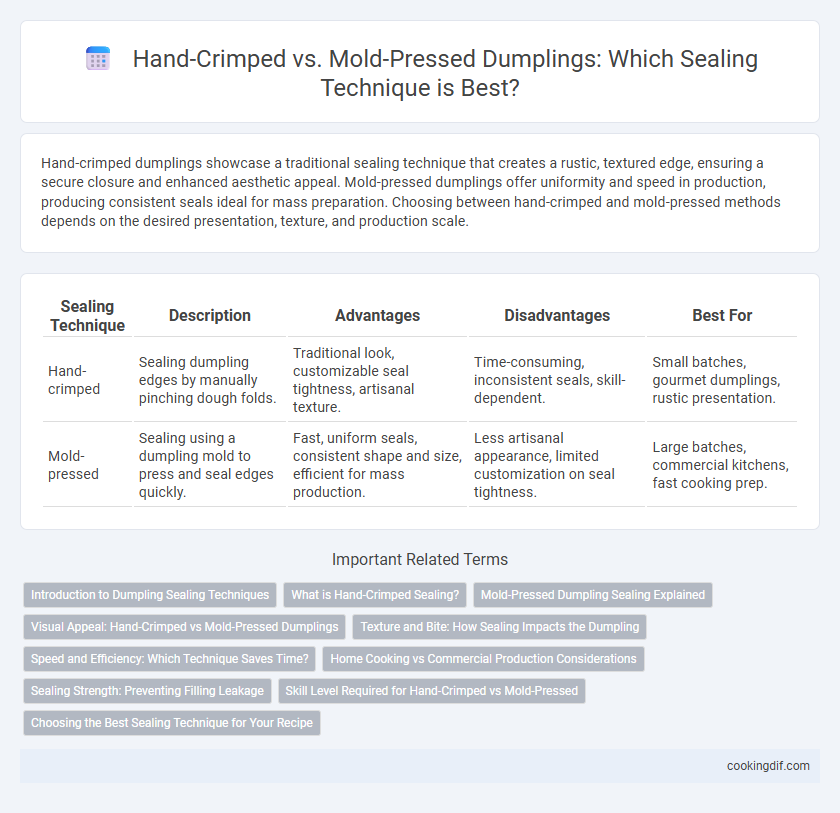Hand-crimped dumplings showcase a traditional sealing technique that creates a rustic, textured edge, ensuring a secure closure and enhanced aesthetic appeal. Mold-pressed dumplings offer uniformity and speed in production, producing consistent seals ideal for mass preparation. Choosing between hand-crimped and mold-pressed methods depends on the desired presentation, texture, and production scale.
Table of Comparison
| Sealing Technique | Description | Advantages | Disadvantages | Best For |
|---|---|---|---|---|
| Hand-crimped | Sealing dumpling edges by manually pinching dough folds. | Traditional look, customizable seal tightness, artisanal texture. | Time-consuming, inconsistent seals, skill-dependent. | Small batches, gourmet dumplings, rustic presentation. |
| Mold-pressed | Sealing using a dumpling mold to press and seal edges quickly. | Fast, uniform seals, consistent shape and size, efficient for mass production. | Less artisanal appearance, limited customization on seal tightness. | Large batches, commercial kitchens, fast cooking prep. |
Introduction to Dumpling Sealing Techniques
Hand-crimped dumpling sealing involves pinching the edges by hand to create a ridged, tightly sealed border, enhancing texture and ensuring the filling stays intact during cooking. Mold-pressed sealing uses a specialized tool to quickly form uniform shapes and seals, offering consistency and efficiency in production. Both techniques affect the dumpling's appearance, cooking method, and overall eating experience, with hand-crimping preferred for artisanal quality and mold-pressing favored in commercial settings.
What is Hand-Crimped Sealing?
Hand-crimped sealing is a traditional dumpling sealing technique where the dough edges are pinched together by hand to create a secure and decorative pleated edge. This method enhances the dumpling's texture and appearance while ensuring the filling remains tightly enclosed during cooking. Hand-crimping allows for greater control over the seal's strength compared to mold-pressed techniques, making it a preferred choice for artisanal dumplings.
Mold-Pressed Dumpling Sealing Explained
Mold-pressed dumpling sealing ensures uniform, airtight edges by using specialized molds that fold and press the dough precisely, enhancing cooking consistency. This technique prevents leakage of fillings during boiling or steaming, preserving the dumpling's shape and flavor integrity. The efficient, repeatable process is ideal for commercial production, offering consistent size and appearance while maintaining structural durability.
Visual Appeal: Hand-Crimped vs Mold-Pressed Dumplings
Hand-crimped dumplings feature irregular, unique pleats that create a rustic and artisanal visual appeal, showcasing the maker's skill and craftsmanship. Mold-pressed dumplings exhibit uniform, symmetrical edges with consistent patterns that enhance presentation, ideal for large batches with a polished appearance. The choice between hand-crimped and mold-pressed techniques significantly impacts the dumpling's aesthetic, influencing customer perception and dining experience.
Texture and Bite: How Sealing Impacts the Dumpling
Hand-crimped dumplings create a thicker, chewy edge that enhances the overall texture and offers a satisfying bite, while mold-pressed seals produce uniform, thin edges that deliver a delicate, smooth mouthfeel. The hand-crimping technique allows dough to retain more elasticity, contributing to a heartier chew, whereas mold-pressed dumplings tend to have a consistent, tender seal that complements softer fillings. Texture and bite significantly influence the eating experience, making the sealing method a key factor in dumpling quality and consumer preference.
Speed and Efficiency: Which Technique Saves Time?
Hand-crimped dumplings offer a traditional sealing method that ensures a secure closure but requires more time and manual skill, making it less efficient for large batches. Mold-pressed dumplings drastically improve speed and consistency, sealing each dumpling uniformly in seconds, which is ideal for high-volume production. Choosing mold-pressed techniques enhances overall efficiency by reducing labor time while maintaining product quality.
Home Cooking vs Commercial Production Considerations
Hand-crimped dumplings offer a rustic, customizable seal ideal for home cooking where variety and personal touch matter, while mold-pressed dumplings provide consistent, uniform sealing suited for high-volume commercial production. Home cooks benefit from the tactile control and artistic flexibility of hand-crimping, enabling diverse shapes and sealing strengths that affect texture and cooking outcome. Commercial operations prioritize mold-pressed techniques for speed, repeatability, and reliable sealing integrity that supports automation and reduces labor costs.
Sealing Strength: Preventing Filling Leakage
Hand-crimped dumplings offer superior sealing strength due to the manual pressure applied along the edges, creating tight, uneven ridges that effectively prevent filling leakage. Mold-pressed dumplings provide uniform seals but may lack the firmness needed to withstand vigorous cooking, increasing the risk of seam bursts. For optimal sealing, hand-crimping ensures a durable barrier that minimizes leakage during boiling or frying processes.
Skill Level Required for Hand-Crimped vs Mold-Pressed
Hand-crimped dumplings require a higher skill level, as the cook must manually pinch and fold the dough edges to create a secure, intricate seal that can hold fillings during cooking. Mold-pressed dumplings offer a more accessible alternative, using a specialized tool to quickly press and seal edges with consistent results, suitable for beginners. Skilled hand-crimping enhances texture and appearance, while mold-pressing prioritizes speed and uniformity in dumpling preparation.
Choosing the Best Sealing Technique for Your Recipe
Hand-crimped dumplings offer a traditional, artisanal seal that enhances texture and allows for varied fillings, making them ideal for recipes requiring a more rustic, homemade appearance. Mold-pressed sealing ensures uniformity and a tighter closure, perfect for recipes with delicate or wet fillings that need secure containment during cooking. Selecting the best sealing technique depends on your recipe's filling consistency, desired presentation, and cooking method to maintain flavor and prevent leakage.
Hand-crimped vs Mold-pressed for sealing technique Infographic

 cookingdif.com
cookingdif.com